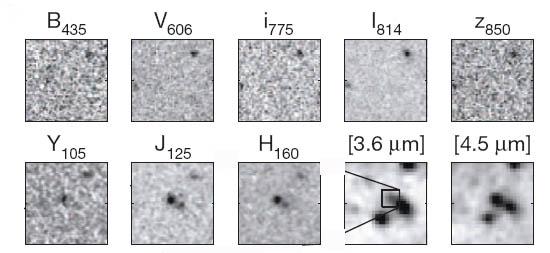- What happened in the early universe?
- Why do galaxies differ so much in size, shape, composition and activity?
- Early Universe
- Starburst Galaxies
- Galaxy Formation and Evolution
- Extragalactic Distance Scale
- Spectroscopy

A galaxy seen 700 million years after the big bang, in a series of eight images of increasing wavelength from the top left (optical) to the bottom right (infrared). The galaxy is so far away, and hence so red-shifted by the expanding universe, that it is not seen in the optical, and only appears in the last two frames (the square identified the object).
About thirteen billion years ago the newborn universe began to produce stars. The first ones appeared only a few hundred million years after the big bang, but they were unlike stars of today. They were, for example, very massive because the infant universe consisted almost entirely of hydrogen and some helium and lacked the elements needed to form solar-type stars. By the time another half a billion years had passed, however, those stars and their descendants had manufactured enough other elements to enrich the natal gas and enable nearly normal stars to form. After a few billion years, galaxies themselves acquired their mature forms. Then, for reasons that are not well understood, galaxies began to make stars as much as ten times faster than they do today, until just a few billion years ago (also for poorly understood reasons) they settled back down into their current phase of activity. This general story has been known for a few decades but lately has become a more pressing research priority because our Milky Way participated in this history, and because the technology to answer such questions is now in hand.
Astronomers can determine the distance of a galaxy from its redshift, the result of the expanding universe. Firm measurements of a redshift, though, are hard to come by for these early galaxies because they are far away and very dim, and the spectroscopic lines used to precisely measure their redness are also faint. Most often the general overall color of a galaxy, when compared to a local galaxy, is taken as a measure of its redness and hence distance. But if the colors of these still somewhat mysterious objects have been distorted by other processes not yet accounted for, those distance estimates will be correspondingly off. Spectral lines provide a much more reliable measure. Currently the five most cosmologically distant galaxies with spectroscopic redshift measurements are from the epoch about 780 million years after the big bang.
CfA astronomers Matt Ashby, Giovanni Fazio, Jia-Sheng Huang, and Steve Willner, along with a large team of colleagues, have now pushed this frontier even further back. Writing in the latest issue of Nature, they describe follow up detections of faint red galaxies discovered in deep-sky images from the Spitzer IRAC camera and the Hubble Space Telescope using the new 10-meter Keck Telescope infrared spectrometer. Among their sample is a galaxy rapidly forming stars from an epoch only 700 million years after the big bang – the most distant, oldest known galaxy with a confirmed redshift (but there are other objects with only color-based redshifts thought to even more distant). They find a surprisingly high rate of star formation in this object, about 100 times larger than in the current Milky Way. The results help the formulation of a detailed picture of early galaxy evolution, and also signal the remarkable technological progress in the study of the very early universe.
"A Galaxy Rapidly Forming Stars 700 Million Years After the Big Bang at Redshift 7.51," S. L. Finkelstein, C. Papovich, M. Dickinson, M. Song, V. Tilvi, A. M. Koekemoer, K. D. Finkelstein, B. Mobasher, H. C. Ferguson, M. Giavalisco, N. Reddy, M. L. N. Ashby, A. Dekel, G. G. Fazio, A. Fontana, N. A. Grogin, J.-S. Huang, D. Kocevski, M. Rafelski, B. J. Weiner& S. P. Willner, Nature 502, 524, 2103
Related News
Astronomers Discover New Building Blocks of Complex Organic Matter
First Rocky Exoplanet Confirmed with NASA's JWST
New from JWST: An Exoplanet Atmosphere as Never Seen Before
Astronomers Warn of Risk of Misinterpreting JWST Planetary Signals
Astronomers Detect Carbon Dioxide on Planet for the First Time with JWST
Stellar Winds and Evaporating Exoplanet Atmospheres
Planets Form in Organic Soups with Different Ingredients
Planetary Remnants around White Dwarf Stars
Mystery Solved: Dust Cloud Led to Betelgeuse's 'Great Dimming'
Harvard Radcliffe Institute Honors Astrophysics Senior with Highest Distinction
Projects
AstroAI
AtomDB
GMACS
For Scientists
HITRAN and HITEMP Database
Sensing the Dynamic Universe
SDU Website